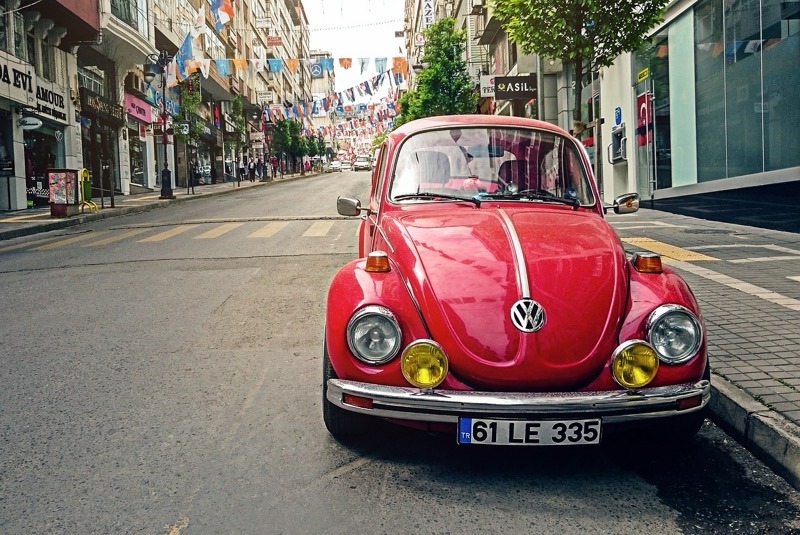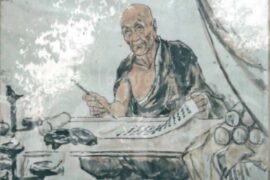In the 1920s, around forty-six per cent of American households owned a car. Ford Motors had brought to market the first car made for the masses. In the early 1930s, the German auto industry was still mainly restricted to luxury models, and few Germans could afford anything more than a motorcycle: one German out of every fifty owned a vehicle. So, in 1933, Hitler directed Ferdinand Porsche to create a Volkswagen, literally translating to the people’s car.
The Volkswagen Beetle was an unfinished Nazi vanity project that was a part of Germany’s darkest hours. Yet it emerged as a symbol of Germany’s postwar economic resurgence and increasing middle-class riches. Long after its end in production, the design of the vehicle is regarded as a classic in the automobile industry.
Pronounced folksvagən, it was commissioned by Hitler as a vehicle that would be made available to all the citizens of the Third Reich through a savings scheme. It would cost them the price they’d typically pay for a motorcycle. The vehicle was designed to carry two adults and three children at a speed of one hundred kilometres per hour.
The initial design of the automobile — a rounded shape with seating for four or five, a nearly vertical windshield, and an air-cooled engine at the back — was created by Austrian engineer Porsche. The design was similar to Czechoslovakia’s 1937 model of Tatra T97 and sketches published by Bela Barenyi, the famous Hungarian engineer.
In fact, in 1953, Barényi established in court that Porsche’s patents were actually his ideas, which he had made five years before Porche claimed to have designed his initial version. He has subsequently been recognised for creating the original design.
The KdF-Wagen, the Nazi labour organisation under whose auspices it was to be sold, barely built 210 beetles. With the exception of two military prototype units, these KdF sedans were issued to military chiefs as personal vehicles. Hitler got the first convertible Beetle in 1938. Due to World War II, the civilian production of the Beetles was put on hold. Instead, the massive new plant in what was previously the countryside, east of Hanover, built military vehicles in appalling conditions, using forced labourers from all across Europe.
Major Ivan Hirst, a British Army officer, was primarily responsible for the factory’s reopening. Hirst was ordered to take charge of the badly destroyed facility that the Americans had taken over. His first duty was to retrieve an unexploded bomb that had fallen through the ceiling and trapped between some crucial manufacturing equipment; if the bomb had burst, the Beetle’s destiny would have been sealed. Hirst convinced the British military to purchase 20,000 cars, knowing Germany needed jobs and the British Army needed vehicles.
Finally, in 1947, the production of Beetles for civilians began with 9000 units. The civilian output bumped up in subsequent years as Heinz Nordhoff, former director of Volkswagen, was appointed as the director of the factory. Under his leadership, a million cars were assembled by 1955, and he brought the plant to become one of the world’s leading car manufacturers.
The United States became Volkswagen’s most significant international market, with a peak of 563,522 vehicles in 1968, accounting for forty per cent of total manufacturing. Doyle Dane Bernbach’s outlandish, often funny advertising encouraged car buyers to “Think small.”
Type 1 was officially named “Beetle” this year (from “der Käfer,” German for the beetle, which was used in brochures). The first of six films starring Herbie the Love Bug, an anthropomorphic 1963 Beetle with a racing-style number 53 on the hood, was released by Disney.
“Unlike in West Germany, where its low price, quality and durability stood for a new postwar normality, in the United States the Beetle’s characteristics lent it a profoundly unconventional air in a car culture dominated by size and showmanship,” Bernhard Rieger wrote in his 2013 history The People’s Car.
Volkswagen unveiled the Super Beetle, a high-end car. Under the hood, the vehicle received a reworked front suspension and a larger trunk capacity. And, on February 17, 1972, the 15,007,034th Beetle rolled off the assembly line, shattering the Ford Model T’s four-decade record as the best-selling vehicle in the world.
The production of the Beetle came to an end at the German factories on 19 January 1978, when the production of Golf, designed by Giorgetto Giugiaro, ramped up. However, the new model launched by Volkswagen did not mark the end of the Beetle.
The production had shifted to Brazil and Mexico because of low operating costs. The production of the Beetle continued in Mexico from 1967 to 2003. The “vochito,” as it was nicknamed, established itself as a rustic, Mexican-made “carro del pueblo.”
Under Ferdinand Piech, Ferdinand Porsche’s grandson, the New Beetle – a fully vintage version built on a modified Golf chassis – revived some of the original Beetle’s charming, unusual aura in 1998. The design of the Beetle was updated in 2012. Around 43,000 beetles were sold in 2013, however, since then, the sales steadily declined to 15,000 in 2017.
Volkswagen declared that the Beetle had reached the end of its production run. Two last versions, the Final Edition SE (starting at $25,995) and the Final Edition SEL (starting at $29,995), both available as convertibles, bid farewell to the legendary vehicle in 2019. The Beetle was the first Volkswagen and one of the first rear-engined automobiles since the Brass Era. It sold 21,529,464 vehicles throughout its production life.
-30-
Copyright©Madras Courier, All Rights Reserved. You may share using our article tools. Please don't cut articles from madrascourier.com and redistribute by email, post to the web, mobile phone or social media.Please send in your feed back and comments to [email protected]











